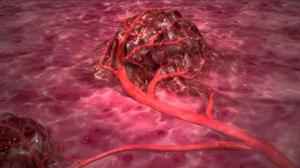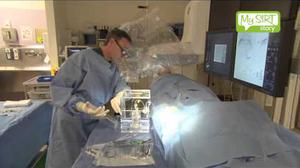
About SIRT
About SIR-Spheres microspheres
How can I get SIRT?
About the SIRT procedure: Before, during & after treatment
About SIRT
What is Selective Internal Radiation Therapy (SIRT)
SIRT involves injecting millions of tiny radioactive 'beads' called microspheres into the main blood vessel of the liver through a long thin tube (catheter). The microspheres travel through the blood to the liver where they lodge themselves in the very small blood vessels in and around the liver tumours where they give off high doses of radiation. As the microspheres only give off radiation to a small area, they target the liver tumour while doing little damage to the surrounding healthy liver tissue. The action of the radiation destroys the liver tumour cells causing the tumours to shrink.
Who can be treated with SIRT?
SIRT is used to treat liver tumours that can't be removed by surgery. SIRT has no effect on tumours outside the liver.
Before SIRT can be offered as a treatment option for patients, there are a number of other factors that have to be considered. Most importantly, you need to have a sufficiently healthy liver. This is usually determined by a simple blood test. The most important thing is for your doctor to assess your condition and to see if SIRT would be suitable.
How often do I need to have the procedure?
For the vast majority of patients only one SIRT treatment will be needed. Rarely a second or subsequent SIRT treatment may be recommended by your doctor.
How long does the radiation stay inside me?
After two weeks only three per cent of the initial useful radiation remains and after one month it all has gone.
Is the radiation harmful?
The dose of treatment that is used will be effective against liver tumours while causing little or no damage to normal liver tissue. As the microspheres only give off radiation to a small area, they target the liver tumour while doing little damage to the surrounding healthy liver tissue.
What happens to the microspheres inside of me?
The microspheres stay in the liver permanently but they are harmless.
Why can't I have conventional 'external beam' radiotherapy?
External beam radiotherapy is the most common type of radiotherapy used in cancer treatment. It uses a machine to focuses beams of radiation from outside the body onto the affected area. However, the liver is especially sensitive to radiation so can only tolerate small doses of external radiotherapy before it starts to damage healthy liver cells, so for this reason is not usually used to treat liver cancer.
SIRT targets liver tumours directly inside the body with radiation while minimising damage to the surrounding healthy liver tissue. For this reason SIRT can deliver much higher doses of radiation over much longer periods of time than would be possible with external beam radiation.
What are the side effects of SIRT?
Almost all treatments and drugs produce unwanted side effects. Most side effects following a SIRT procedure are minor, but a small number can be serious. Many patients experience tummy pain or tightness, nausea and loss of appetite which normally subsides within a week. Patients may also develop a mild fever that may last for up to a week and fatigue that may last for several weeks.
Will I lose my hair?
Hair loss has not been reported following treatment. If you are receiving chemotherapy this may cause hair loss, however SIRT will not make this worse.
What are the potential complications of SIRT?
In rare instances, a small number of microspheres may inadvertently reach other organs in the body, such as the gallbladder, stomach, intestine, or pancreas. If microspheres reach these organs, they can cause inflammation or ulceration. These complications are rare, but if they do occur they will require additional medical treatment.
About SIR-Spheres microspheres
SIR-Spheres microspheres improve survival by about five months in some patients with bowel cancer that has spread to the liver and who have failed previous chemotherapy.
In combination with chemotherapy, SIR-Spheres microspheres can reduce the size of liver tumours, increase life expectancy and improve quality of life for some patients with bowel cancer that has spread to the liver.
The National Institute for Care & Health Excellence reviewed SIRT for use in patients with both liver tumours that have spread from the bowel1 and primary liver cancer2 that cannot be treated by surgery and concluded:
- Current evidence on the safety of SIRT is adequate
- SIRT can delay the progression of the disease
- In some cases liver tumours shrunk sufficiently so that they could be surgically removed
- More comparative research is needed
Click here for NICE guidance for SIRT
How can I get SIRT?
There are three ways in which you can get SIRT treatment:
- NHS: NHS England have announced that from April 2019 selective internal radiation therapy (SIRT) using yttrium-90 microspheres will be available as a routinely commissioned NHS treatment for patients with advanced bowel cancer that has spread to the liver and is not responding to standard chemotherapies.
In the Clinical Commissioning Policy paper: Selective Internal Radiation Therapy (SIRT) for chemotherapy refractory/intolerant metastatic colorectal cancer (adults), NHS England recommends that adults with chemotherapy refractory or chemotherapy intolerant unresectable, liver-only metastatic colorectal cancer that meet all of the eligibility criteria will be able to be treated with SIRT using yttrium-90 microspheres.2
For patients with advanced bowel cancer, patients will have to meet certain criteria to be eligible for the treatment on the NHS. Specialist liver centres in England which satisfy the criteria specified by NHS England will be able to routinely offer this procedure.
The liver metastases should not be operable and the disease should not be responding to standard chemotherapies. For patients with other cancers that may benefit from SIRT, such as primary cancers of the liver, the policy proposals are still being reviewed.
You will need to discuss this further with your own clinician in the first instance. - Private funding: It may be paid for privately and can be accessed throughout the UK at hospitals with treatment teams trained in the SIRT procedure. Most major insurers in the UK fund SIRT. If you have private medical insurance, speak to your provider to see if you are covered.
- Clinical trials: Clinical trial information will be published when it is available.
What should I do if I am not eligible for SIRT treatment on the NHS?
If you are not eligible for SIRT treatment on the NHS, an application can be made under exceptional circumstances but there is no obligation for the NHS to fund the treatment. This process can also take some time.
You may also be able to join a clinical trial. Clinical trials will be listed as they become available.
If you are having problems accessing SIRT, you may be able to seek further advice on other options from one of the support groups in the 'patient support' section.
What should I do if I'm waiting a long time for SIRT treatment?
If you find that you are having to wait a long time to be treated with SIRT at your nearest hospital, it is possible for your doctor to refer you to another SIRT approved hospital that may have a shorter waiting list so you can be treated more quickly.
Where is my nearest SIRT approved hospital?
For private patients, please email us at info@mysirtstory.co.uk to find your nearest SIRT approved hospital.
For NHS patients, you can search for your nearest NHS approved hospital by clicking here.
SIRT procedure: Before, during and after treatment
Before:
What will my treatment team do before administering SIRT?
Your treatment team will want to know about your previous cancer history and any other medical conditions. They will then conduct a number of initial tests to ensure that it is possible for you to receive SIRT safely. Normally patients will undergo two procedures. Both procedures will include a procedure known as a liver angiogram. The purpose of the angiogram is to map the blood vessels in the liver and to block-off (embolise) some of the vessels to minimise the potential for the microspheres to travel to areas outside your liver (e.g. the stomach or lungs). You will also receive a small amount of radioactive "test beads" to check the amount of blood that flows from the liver to the lungs.
Assuming that the results of these initial tests are acceptable, the dose of SIR-Spheres microspheres will be determined. The SIR-Spheres microspheres will then be given during a second procedure that is typically conducted one to two weeks after the initial tests are completed.
Is there anything I must avoid?
You must not receive SIRT treatment if you are pregnant and you must not become pregnant within two months of being treated as this may cause irreversible harm to the unborn baby.
For men, you must not father children for at least two months from SIRT treatment.
Effective contraception must be used at all times during this period. You must not breastfeed during the first two weeks after treatment and must not use any milk expressed during this period for bottle feeding your baby.
During:
How is SIRT administered?
The SIRT procedure is conducted by a medical team that includes a specialist known as an interventional radiologist, together with other specialists trained to work with radiation.
The procedure can typically take around one hour from beginning to end. Usually you will need to stay in hospital overnight.
The doctor will give you an injection to numb the area around your groin and give you a sedative to help you relax. Pain relief and anti-sickness medication may be provided if you need it. A small cut is made in the groin through which a soft, flexible tube (catheter) is inserted and guided into the liver up a blood vessel (femoral artery) using x-ray pictures. The microspheres are then given through the catheter.
After:
What will happen after I have received SIRT?
Immediately following the SIRT procedure, you may be taken for a scan to confirm that the SIR-Spheres microspheres have been delivered into your liver correctly. You will also be monitored for a few hours after the procedure to enable the treatment team to determine whether you have any side effects that require additional medication.
Since you will have received a radioactive treatment, there are some simple precautions that need to be taken after treatment. You will be provided with further information on these precautions by your treatment team.
It is also important to drink plenty of fluids for six to eight weeks after this procedure.
Typically you will be given some medication to counteract some of the potentially common side-effects of SIRT treatment
Your treatment team will also monitor your progress using blood tests and radiography scans at periodic intervals.
What special precautions need to be taken after treatment?
There are some simple precautions that patients need to take during the first 24 hours following the SIRT procedure. These precautions include: thorough hand washing after using the toilet, and cleaning up any spills of body fluids such as blood, urine or stools and disposing of them in the toilet.
Prolonged, close physical contact with pregnant women and children should be avoided for seven days after treatment.
What should I do if I experience a side effect?
It is important that you contact your doctor or nurse if you experience a side effect. Your doctor might prescribe medications to ease any discomfort. Although it is rare that side effects become life threatening, it is important to tell your doctor as soon as you experience any unwanted reactions.
How soon can I go home after SIRT?
Your doctor may keep you in hospital for one or two nights to ensure you do not develop any complications following treatment. Usually patients who have received SIRT can go home the following day or two after treatment and most soon resume their normal daily activities.
Will I have to change what I eat or drink?
No. You can and should continue to eat and drink as normal. Adequate levels of food and, in particular, fluids will help you return to your normal daily activities. Your doctor is the best person to advise you regarding alcohol consumption.
- NICE. Guidance IPG401. Last updated May 2013
- NICE. Guidance IPG460. July 2013

There are three ways in which you can get SIRT treatment:





























